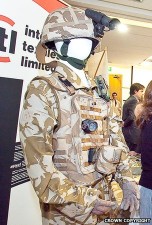The ‘internet of things’ is coming with companies spending big money on research and development (R&D) and marketing to make sure your next fridge, washing machine and coffee maker will be hooked up to the internet. Web-connected electricity meters are already available for installation, and many cars are already using the internet for directions – in a few years they might not even need drivers at all.
But what you might not have thought about is how the internet of things can be put to use by armed forces, to better understand what’s going on around them and effectively ‘plug in’ to the battlefield.
As Selex-ES Chief Technology Officer at Finmeccanica, I am interested in how the internet of things could help our troops win battles in future conflicts. There are a few areas where I believe we could see this help including:
The internet will be part of a soldier’s uniform, not his kit.
As the Internet of Things matures and the big defence companies

spend R&D pounds on developing the technology, the tech to ensure objects are internet aware become smaller and smaller. Eventually, connectivity won’t require separate equipment, but will be woven into fabrics and other materials. The internet will be connected to a soldier’s uniform itself, as well as his weapons and other equipment.
Batteries will be a thing of the past.
With data being generated from clothing, weapons and other kit in real time, you might reasonably ask where the power will come from to run all this connectivity. The answer is everywhere except batteries. There’s a number of technologies in the pipeline including generating micro-power from movement or better harvesting solar energy. A recently announced nano-radio with a 20-inch range actually harvests power from the radio frequency energy itself.
Everything will be a sensor.
Generally, when you hear the word ‘sensor’, you think of bulky additional bits of kit like binoculars or night vision cameras. But once everything is connected to the internet, everything becomes a sensor. Web-linked uniforms could upload the temperature of soldiers and net-connected weapons could report a squad’s ammo-count down to the last bullet. With everything active online, troops will be able to generate a complete picture of the battlefield down to the level of the individual soldier.
Soldiers will subscribe to information ‘channels’.
All this of course begs the question: Can’t this massively increased level of information also cause problems for soldiers? After all, they have to pay attention to their surroundings as well. It’s an issue that defence equipment providers are carefully considering. One solution would see operational teams subscribing to data channels that are relevant to them, at their location, at that time.
Whatever solution is eventually adopted, it’s clear that the soldiers of the future will be web-connected and more informed than ever before.
The UK Government has identified ‘eight great technologies’ including the internet of things, plus a further two which will propel the UK to future growth. Eight Great Technologies: The Internet of Things aims to help people understand the technologies and the direction of future funding,
Read more about intelligent textiles in MOD's science and technology magazine - Defence Codex.
